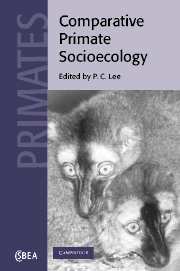Book contents
- Frontmatter
- Contents
- List of contributors
- Preface
- Part 1 Comparative methods
- Part 2 Comparative life history and biology
- Part 3 Comparative socioecology and social evolution
- 10 Lemur social structure and convergence in primate socioecology
- 11 Why is female kin bonding so rare? Comparative sociality of neotropical primates
- 12 Energetics, time budgets and group size
- 13 Ecology of sex differences in great ape foraging
- 14 Hominid behavioural evolution: missing links in comparative primate socioecology
- 15 Evolutionary ecology and cross-cultural comparison: the case of matrilineal descent in sub-Saharan Africa
- Editor's conclusion: Socioecology and social evolution
- Index
13 - Ecology of sex differences in great ape foraging
Published online by Cambridge University Press: 24 August 2009
- Frontmatter
- Contents
- List of contributors
- Preface
- Part 1 Comparative methods
- Part 2 Comparative life history and biology
- Part 3 Comparative socioecology and social evolution
- 10 Lemur social structure and convergence in primate socioecology
- 11 Why is female kin bonding so rare? Comparative sociality of neotropical primates
- 12 Energetics, time budgets and group size
- 13 Ecology of sex differences in great ape foraging
- 14 Hominid behavioural evolution: missing links in comparative primate socioecology
- 15 Evolutionary ecology and cross-cultural comparison: the case of matrilineal descent in sub-Saharan Africa
- Editor's conclusion: Socioecology and social evolution
- Index
Summary
Sex differences in great ape foraging stragegy vary between populations as well as species. Are these sex differences functions of the energetic constraints of the sexes and thus represent a maximisation of individual fitness goals, or are they a group adaptation that minimises feeding competition?
Male and female energetic constraints
Male and female energetic constraints (the costs of metabolism, activity and reproduction) result from two factors: (1) the degree of sexual dimorphism in body weight that exists between the sexes, and (2) the reproductive state of the individual.
Male primates are often larger than female primates. Large differences in body size have significant energetic consequences. While metabolic rate increases with body size as around body weight0.75, commonly the rate of food intake may increase less rapidly with body weight (Clutton-Brock, 1994). Furthermore, heavier bodied animls are further constrained by their greater weight and size and are thus less able to exploit certain areas of food patches such as the outer branches of fruiting trees (Doran, 1993a, 1993b). Conversely, weaker, smaller animals are less able to exploit resources that require greater strength for their processing such as the stripping of bark. Smaller animals are also more likely to be displaced at food sources by larger ones (Wheatley, 1982).
The degree of sexual dimorphism in body mass will therefore affect the amount of sexual segregation within a habitat. A large degree of sexual dimorphism produces males as large-bodied foragers and females as smaller bodied foragers. Males and females are thus under differing selective pressures due to their body size and effectively occupy different niches within the same habitat.
- Type
- Chapter
- Information
- Comparative Primate Socioecology , pp. 339 - 362Publisher: Cambridge University PressPrint publication year: 1999
- 16
- Cited by



